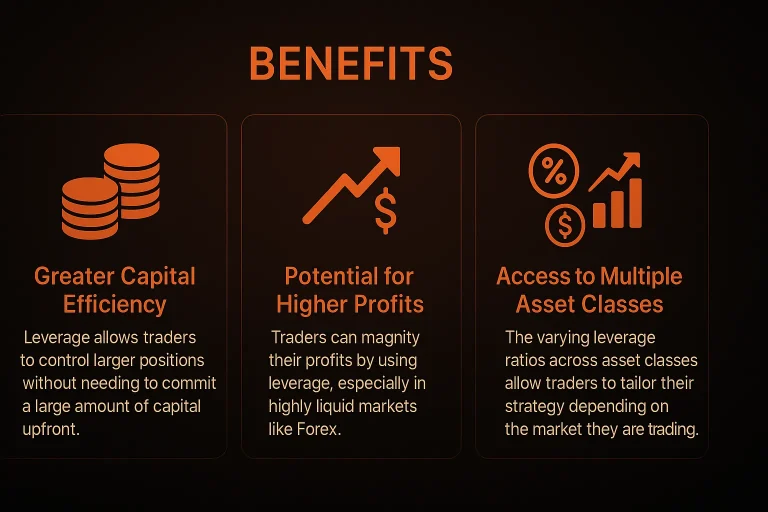Funding Traders Leverage
25% off first order: SABIO2025
What is Leverage in Trading?
Leverage in trading refers to the ability to control a large position in the market with a relatively small amount of capital. Essentially, leverage allows traders to amplify their trades by borrowing capital from the trading platform. While this can increase the potential for profits, it also increases the potential for losses, making it essential for traders to use leverage cautiously.
At Funding Traders, leverage is offered across various asset classes, including Forex, indices, gold, and cryptocurrencies. Each asset class has its own leverage ratio, tailored to its volatility and risk profile.
Funding Traders Leverage Across Different Asset Classes
The leverage varies depending on the type of asset being traded. Below are the leverage ratios available for different asset classes on the platform:
Asset Class | Leverage Offered |
Forex (FX) | Up to 1:100 |
Indices | Up to 1:50 |
Gold | Up to 1:50 |
Cryptocurrencies | Up to 1:5 |
1. Forex (FX) Leverage – Up to 1:100
Leverage on Forex pairs allows traders to access up to 1:100 leverage. This high leverage ratio is common in the Forex market due to the high liquidity and relatively small price movements in currency pairs. Traders who are able to use this leverage effectively can control larger positions with smaller capital, allowing them to take advantage of small price changes.
However, it’s important to note that using high leverage in the Forex market can increase risk. For example, a small unfavorable movement in the market can result in significant losses if the position size is too large relative to the capital invested. Traders should therefore be mindful of their risk management strategies when trading Forex with high leverage.
2. Indices and Gold Leverage – Up to 1:50
For indices and gold, leverage is set at a more conservative ratio of 1:50. These markets are typically less volatile than Forex pairs, but they can still experience significant price movements. The reduced leverage is designed to help traders maintain a balanced approach while trading these markets.
Indices, which represent a basket of stocks, and gold, a well-known safe-haven asset, tend to attract longer-term traders. While the leverage is lower than Forex, it still provides traders with ample opportunity to gain exposure to these assets and take advantage of larger price swings.
3. Cryptocurrency Leverage – Up to 1:5
Cryptocurrencies are notoriously volatile, which is why leverage for crypto trading is capped at 1:5. This conservative leverage ratio ensures that traders are not overexposing themselves to the risks associated with cryptocurrency trading.
With cryptocurrencies, a small price movement can lead to substantial gains or losses. The limited leverage helps protect traders from excessive risks while still allowing them to participate in the market. This is especially important given the unpredictable nature of crypto markets, where prices can swing dramatically within short periods.

How Leverage Affects Trading Strategy
Leverage can be a powerful tool for traders, but it requires careful management. Below are some important considerations on how leverage on Funding Traders can influence trading strategies:
1. Amplified Potential for Profit and Loss
Leverage magnifies both the potential profit and loss of a trade. A trader using high leverage in the Forex market (up to 1:100) can amplify small price movements and generate greater profits. Conversely, this also means that small adverse price movements can result in significant losses. Traders must therefore use stop-loss orders and other risk management techniques to protect their capital.
2. Risk Management
With leverage, traders need to have a clear risk management strategy in place. This includes setting appropriate position sizes, using stop-loss orders, and diversifying the trading portfolio. Overleveraging can lead to a complete loss of the capital invested, which is why leverage is designed to allow traders to scale their positions based on their risk tolerance.
3. Trading Style
The amount of leverage used in trading will largely depend on a trader’s style. For example, day traders and scalpers tend to use higher leverage to capitalize on small price movements within short timeframes. Conversely, long-term traders may prefer lower leverage to reduce the risk of significant price fluctuations over time.
Key Benefits and Drawbacks of Leverage at Funding Traders
Understanding the benefits and drawbacks of Funding Traders leverage is essential for traders seeking to maximize their profitability while minimizing risk. Below are some key points to consider:
Benefits
- Greater Capital Efficiency: Leverage allows traders to control larger positions without needing to commit a large amount of capital upfront.
- Potential for Higher Profits: Traders can magnify their profits by using leverage, especially in highly liquid markets like Forex.
- Access to Multiple Asset Classes: The varying leverage ratios across asset classes allow traders to tailor their strategy depending on the market they are trading.
Drawbacks
- Higher Risk of Losses: Leverage amplifies both gains and losses. If the market moves against a trader’s position, they could lose more than their initial capital.
- Requires Strong Risk Management: Traders must be disciplined in managing their risk, which includes setting stop-losses and position limits.
- Limited Leverage on Volatile Assets: Assets like cryptocurrencies have limited leverage due to their high volatility, which may disappoint traders looking for larger leverage ratios.

The Role of Leverage at Funding Traders
In conclusion, leverage plays a crucial role in shaping the trading experience on the platform. By offering a range of leverage ratios across various asset classes, the platform provides traders with the flexibility to develop their own strategies while managing their risk exposure. High leverage in Forex allows traders to control larger positions with smaller amounts of capital, while the more conservative leverage on indices, gold, and cryptocurrencies helps mitigate the risks associated with these markets.
Ultimately, leveraging at Funding Traders can be an effective tool for experienced traders who understand the risks and have solid risk management strategies in place. New traders, on the other hand, should approach leverage cautiously and ensure they are well-prepared to handle the potential risks involved.
FAQ:
Leverage in trading at Funding Traders allows traders to control a larger position with a smaller amount of capital. It amplifies both the potential for profit and the risk of loss.
Funding Traders offers leverage of up to 1:100 for Forex trading, allowing traders to control larger positions with less capital.
Leverage allows you to amplify your trades, but it also increases the potential for both profit and loss. It’s important to manage your risk carefully when using leverage in your trading strategy.
Funding Traders offers leverage of up to 1:5 for cryptocurrency trading. This lower leverage ratio helps mitigate the risks associated with the high volatility of cryptocurrencies.
To manage risk when using leverage, you should set appropriate position sizes, use stop-loss orders, and avoid overleveraging your positions. Proper risk management is crucial to protect your capital.




